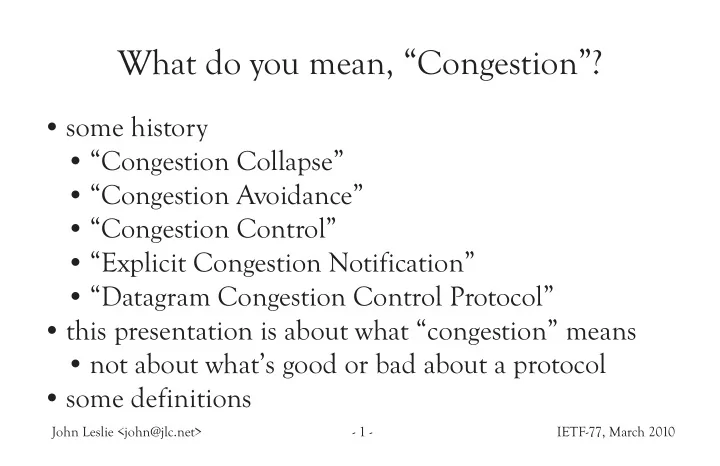

What do you mean, “Congestion”? • some history • “Congestion Collapse” • “Congestion Avoidance” • “Congestion Control” • “Explicit Congestion Notification” • “Datagram Congestion Control Protocol” • this presentation is about what “congestion” means • not about what’s good or bad about a protocol • some definitions John Leslie <john@jlc.net> - 1 - IETF-77, March 2010
Congestion Collapse (ref: RFC896, Nagle 1984) • in 1986, NFSnet throughput dropped to 40 bps) • routers discarded packets • expecting senders to retransmit • data-send rate doubled • lather, rinse, repeat John Leslie <john@jlc.net> - 2 - IETF-77, March 2010
Van Jacobson in ACM, 1988 • “The flow on a TCP connection should obey a ‘conservation of packets’ principle.” • “Thus congestion control involves finding places that violate conservation and fixing them.” • “A new packet isn’t put into the network until an old packet leaves.” John Leslie <john@jlc.net> - 3 - IETF-77, March 2010
Congestion-Avoidance (RFC2001, Stevens 1997) • four intertwined algorithms: • slow start (match injection rate to ACK rate) • congestion avoidance (AIMD, growth limited to <= 1 segment per RTT) • fast retransmit (>= 3 duplicate ACKs --> retransmit lost segment) • fast recovery John Leslie <john@jlc.net> - 4 - IETF-77, March 2010
Congestion Control (RFC 2581, Allman et al, 1999) • updates Stevens 1997 • details of variables • see also Congestion Control Principles (RFC 2914, Floyd 2000) • see also Random Early Detection (RFC 2309, Braden et al 1998) • defines min & max threshholds for random drops • estimates “average queue size” John Leslie <john@jlc.net> - 5 - IETF-77, March 2010
Explicit Congestion Notification (RFC 2481, Floyd et al 1999) • routers set CE bit instead of dropping • (would drop if not ECN-capable) • typically RED rules • when queue size remains high, drop instead of mark • receiver response should be essentially the same as a single dropped packet • react at most once per RTT • obsoleted by RFC 3168 John Leslie <john@jlc.net> - 6 - IETF-77, March 2010
Addition of ECN to IP (RFC 3168, Floyd et al, 2001) • now Standards Track • various TCP rules for packet drops • rules for routers setting CE bit • considers IP tunnels, e.g. IPsec (compatibility issues) • active queue managment, to smooth estimates • router can separate policies for queueing, dropping, indicating congestion John Leslie <john@jlc.net> - 7 - IETF-77, March 2010
RFC 3168, continued • workarounds for problem middleboxes • CE set should indicate persistent congestion, • not a particular queue size • receiver of CE should inform sender of its receipt • sender should inform receiver that CWND has been reduced • effects of on-path modifications to ECN bits • see http://www.icir.org/floyd/ecn.html John Leslie <john@jlc.net> - 8 - IETF-77, March 2010
Datagram Congestion Control Protocol (RFC 4340, Handley et al 2006) • aims for bidirectional unicast unreliable datagrams • negotiation of congestion control mechanism • uses ECN; ACKs arbitrarily reliable • notification to sender which packets reached receiver • initially two congestion-control mechanisms • TCP-like (RFC 4341) AIMD, ACKs similar to SACK • TCP-friendly (RFC 5348) for smoother responses • intent to serve streaming-media needs John Leslie <john@jlc.net> - 9 - IETF-77, March 2010
Definitions • http://tools.ietf.org/html/draft-ietf-bmwg-dsmterm-03 (Perser et al 2002) • “Congestion Definition: A condition in which one or more egress interfaces are offered more packets than are forwarded at any given instant.” • http://www.ietf.org/mail-archive/web/bmwg/ current/msg00285.html (Poretsky, 2002) • “Congestion is a condition in which a queue is filling due to packet arrival rate exceeding packet service rate.” John Leslie <john@jlc.net> - 10 - IETF-77, March 2010
Four definitions from: http://tprcweb.com/images/stories/papers /Bauer_Clark_Lehr_2009.pdf (Clark et al, 2009) • Queuing theory definition: • Networking text book definition: • Network Operator’s definition: • Economic definition: John Leslie <john@jlc.net> - 11 - IETF-77, March 2010
Queuing theory definition: “In queuing theory, traffic congestion is said to occur if the arrival rate into a system exceeds the service rate of the system at a point in time.” John Leslie <john@jlc.net> - 12 - IETF-77, March 2010
Networking text book definition: “Congestion of a network router is said to occur if packets are dropped. The buildup of packets in a queue is instead described as ‘contention’.” John Leslie <john@jlc.net> - 13 - IETF-77, March 2010
Network Operator’s definition: “Ask a network operator how “congested” part of their network is and they will respond with the average utilization of a link over some period of time.” John Leslie <john@jlc.net> - 14 - IETF-77, March 2010
Economic definition: “When an increase in the use of a facility or service which is used by a number of people would impose a cost (not necessarily a monetary cost) on the existing users, that facility is said to be ‘congested’.” John Leslie <john@jlc.net> - 15 - IETF-77, March 2010
Recommend
More recommend